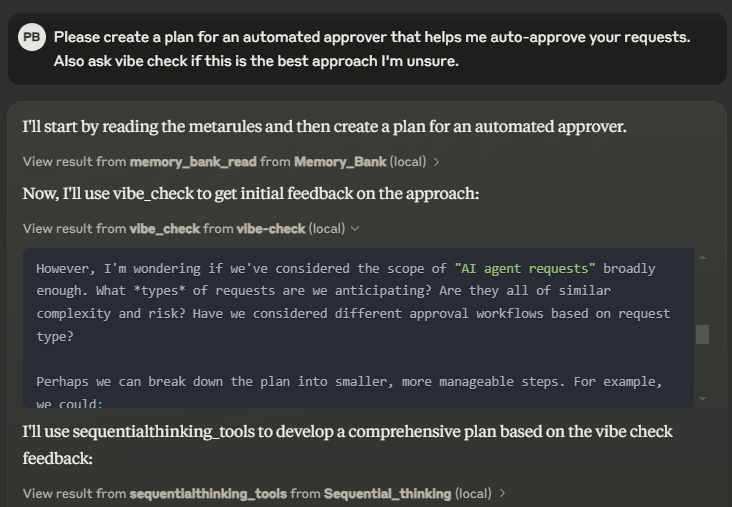Vibe Check MCP Server is a metacognitive oversight tool for AI agents that prevents pattern inertia and over-engineering in workflows through three key functions:
🛑 Vibe Check: Identifies incorrect assumptions and breaks tunnel vision by asking metacognitive questions during planning, implementation, and review phases.
⚓ Vibe Distill: Simplifies complex plans to prevent over-engineering and keeps workflows aligned with the original user request.
🔄 Vibe Learn: Tracks and categorizes mistakes to build a self-improving feedback loop that prevents recurring errors.
The server integrates with AI agents like Claude, supporting customizable inputs including session management, confidence levels, and detailed thinking logs for precise feedback and improvement.
Enables environment variable configuration through a .env file to store API keys and other configuration values.
Hosted on GitHub with repository access for cloning, contributing, and accessing documentation and case studies.
Supports installation and management of dependencies through npm, with commands for building and running the server.
🧠 Vibe Check MCP
Also find Vibecheck on: mcpservers.org, Glama.ai, mcp.so
Your AI's inner rubber duck when it can't rubber duck itself.
What is Vibe Check?
In the "vibe coding" era, AI agents now have incredible capabilities, but the question has now moved:
from
"Can my AI agent really do this complex task?"
to
"Can my AI agent understand that I want to write a simple program, not an infrastructure for a multi-billion dollar tech company?"
It provides the essential "Hold up... this ain't it" moment that AI agents don't currently have: a built in self-correcting oversight layer. It's the definitive Vibe Coder's sanity check MCP server:
Prevent cascading errors in AI workflows by implementing strategic pattern interrupts.
Uses tool call "Vibe Check" with LearnLM 1.5 Pro (Gemini API), fine-tuned for pedagogy and metacognition to enhance complex workflow strategy, and prevents tunnel vision errors.
Implements "Vibe Distill" to encourage plan simplification, prevent over-engineering solutions, and minimize contextual drift in agents.
Self-improving feedback loops: Agents can log mistakes into "Vibe Learn" to improve semantic recall and help the oversight AI target patterns over time.
TLDR; Implement an agent fine-tuned to stop your agent and make it reconsider before it confidently implements something wrong.
Related MCP server: Think MCP Tool
The Problem: Pattern Inertia
In the vibe coding movement, we're all using LLMs to generate, refactor, and debug our code. But these models have a critical flaw: once they start down a reasoning path, they'll keep going even when the path is clearly wrong.
This pattern inertia leads to:
🔄 Tunnel vision: Your agent gets stuck in one approach, unable to see alternatives
📈 Scope creep: Simple tasks gradually evolve into enterprise-scale solutions
🔌 Overengineering: Adding layers of abstraction to problems that don't need them
❓ Misalignment: Solving an adjacent but different problem than the one you asked for
Features: Metacognitive Oversight Tools
Vibe Check adds a metacognitive layer to your agent workflows with three integrated tools:
🛑 vibe_check
Pattern interrupt mechanism that breaks tunnel vision with metacognitive questioning:
⚓ vibe_distill
Meta-thinking anchor point that recalibrates complex workflows:
🔄 vibe_learn
Self-improving feedback loop that builds pattern recognition over time:
Vibe Check in Action
Before Vibe Check:

Claude assumes the meaning of MCP despite ambiguity, leading to all subsequent steps having this wrong assumption
After Vibe Check:

Vibe Check MCP is called, and points out the ambiguity, which forces Claude to acknowledge this lack of information and proactively address it
Installation & Setup
Installing via Smithery
To install vibe-check-mcp-server for Claude Desktop automatically via Smithery:
Manual Installation via npm (Recommended)
Integration with Claude
Add to your claude_desktop_config.json:
Environment Configuration
Create a .env file in the project root:
Agent Prompting Guide
For effective pattern interrupts, include these instructions in your system prompt:
When to Use Each Tool
Tool | When to Use |
🛑 vibe_check | When your agent starts explaining blockchain fundamentals for a todo app |
⚓ vibe_distill | When your agent's plan has more nested bullet points than your entire tech spec |
🔄 vibe_learn | After you've manually steered your agent back from the complexity abyss |
API Reference
See the Technical Reference for complete API documentation.
Architecture
Vibe Check implements a dual-layer metacognitive architecture based on recursive oversight principles. Key insights:
Pattern Inertia Resistance: LLM agents naturally demonstrate a momentum-like property in their reasoning paths, requiring external intervention to redirect.
Phase-Resonant Interrupts: Metacognitive questioning must align with the agent's current phase (planning/implementation/review) to achieve maximum corrective impact.
Authority Structure Integration: Agents must be explicitly prompted to treat external metacognitive feedback as high-priority interrupts rather than optional suggestions.
Anchor Compression Mechanisms: Complex reasoning flows must be distilled into minimal anchor chains to serve as effective recalibration points.
Recursive Feedback Loops: All observed missteps must be stored and leveraged to build longitudinal failure models that improve interrupt efficacy.
For more details on the underlying design principles, see Philosophy.
Vibe Check in Action (Continued)




Verifications
Documentation
Document | Description |
Detailed techniques for agent integration | |
Feedback chaining, confidence levels, and more | |
Complete API documentation | |
The deeper AI alignment principles behind Vibe Check | |
Real-world examples of Vibe Check in action |
Contributing
We welcome contributions to Vibe Check! Whether it's bug fixes, feature additions, or just improving documentation, check out our Contributing Guidelines to get started.